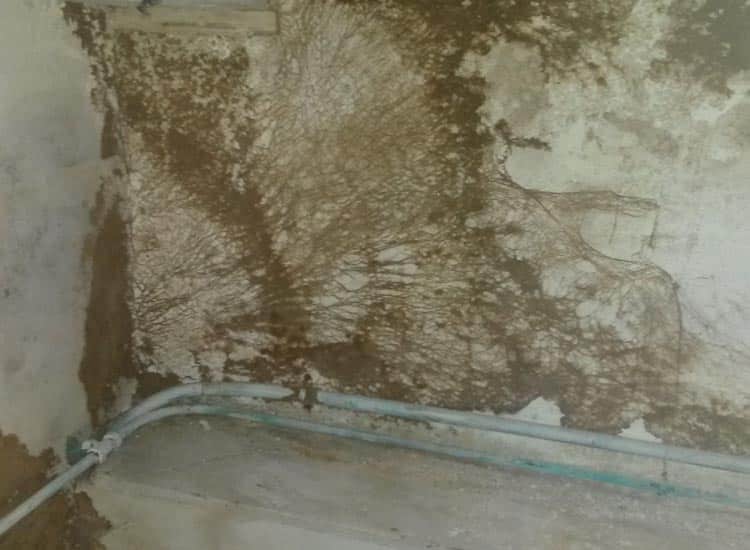What Is Wet Rot?

If you think you have identified decay in your property it is important that the issue is inspected, and repair work is carried out as soon as possible. Regardless of whether your property is a new build or an older property it can still suffer from dry or wet rot.
Wood becoming wet provides the platform which allows fungal decay to develop. Timbers suffering from decay will normally have a minimum moisture content of 20%. Locating the cause of the water ingress and rectification is critical to allow the timber to dry.
Wet and dry rot begin their life cycle in a similar manner when spores of the fungus are germinated on damp wood. When wood destroying fungi begins to attack a piece of timber and create a fruiting body, they release huge amounts of microscopic spores which are widely spread by air currents. Wood which is damp and has not been treated by a fungicide protective treatment may be susceptible to decay. Mycelium will develop within the timber and will start to break down the wood. The timber shrinks and can show a cracked and dark appearance.
Wet Rot Timber Decay
Wet rot is a fungus which attacks unprotected timbers in a property when they have become wet. If the environmental conditions are suitable for wet rot, the rot can develop and result in the breakdown of the structural integrity of the affected timbers. A water penetration issue or defective internal plumbing can provide the perfect conditions for timber decaying fungi to thrive.
There are numerous different species of wet rot though, which can prove problematic to the homeowner when trying to diagnose what type of rot problem is affecting their property.
What Causes Wet Rot?
Wet rot tends to thrive in timber which has a moisture content between 25% and 50%. Rot can occur from a variety of different causes. However, the most likely causes of the damp are:
- Defective rainwater goods, defective roof coverings and masonry.
- Defective seals on showers or baths.
- Defective plumbing to sinks, baths, washing machines, dishwashers, etc.
- Rising Damp.
Wet rot can occur in any area of a property where damp is present, and the damp has been in contact with the wood for a prolonged period.
The source of the moisture must be identified and rectified to ensure the new timbers are maintained in a dry condition and the property fabric can dry to normal moisture levels.
Where Can Wet Rot Occur?
Moisture is the source of all rot attacks. By keeping your property in a good state of repair and wind and watertight you are reducing the risk of decay developing. Wet rot can affect timber at any level of your property. Some of the most common external defects noted are;
- Defective roof coverings and flashings
- Defective gutters and downpipes
- Defective masonry pointing or render
- Path levels which are raised can provide water access above your property’s damp proof course which can result in damp penetrating your home. You can rectify this by having the damp proof course checked by a professional and having the paths lowered.
- Timbers on the ground floor are more susceptible to decay if air bricks are blocked or missing.
- Damaged or blocked drains caused by debris such as leaves is a common cause of water penetration.
There are many potential causes, but the ones outlined above are the most obvious and easiest to resolve. If you identify these issues around a property which you are about to buy or sell, you should consider a specialist survey be undertaken.
Decay in Upper Flooring and Roofs
Wet rot occurring in the upper flooring and roof timbers is less common than in ground floor timbers, due to ground floor timbers potentially being in closer contact with damp soil areas and rising damp and less likely to be seen. The most common causes of water ingress to upper areas of a property are listed below;
- Defective flashing around chimneys can result in long term water penetration into your property. In some instances, this may not appear as water staining on the ceilings and therefore not visually apparent internally. This water ingress can result in the timbers surrounding the chimney becoming decayed. It is prudent to have your roof coverings inspected by a roofing contractor on an annual basis.
- Slipped tiles can allow water ingress which may provide suitable conditions for dry rot or wet rot. If dealt with quickly damp issues to your property will not arise, but if left untreated decay may develop.
- Wet stains or algae growth below gutters should be a red flag for property owners. Ensure that these are repaired whenever necessary and are kept clear.
- Upstairs bathroom floors and central heating systems may have overflow pipes which protrude out from the walls. It is important that these are not dripping. Also, defective plumbing may be hidden behind walls and under floors. If issues are noted to these pipes a plumber should be called to rectify the issue and the property dried out.
How to Identify Wet Rot?
Wet rot has a specific life cycle. At its inception, this type of rot will begin to develop strands which feed from the timber cells causing the timber to shrink and then will create a fruiting body which releases spores. The presence of wet rot within timber will cause the timber to begin to change colour. The timber will usually turn darker however it can turn considerably lighter but this is down to environmental factors. The timber will become spongy and soft to touch.The decay caused by wet rot tends to be localised to one specific area (The area of the water ingress / leak). Construction timbers within properties such as windowsills, floorboards and skirting boards will normally show clear signs of a wet rot problem through the paintwork flaking and becoming generally damaged.
Wet rot is usually accompanied by a damp and musty smell which is very obvious around the timber which is infected. However, one of the biggest issues which property owners face surrounding wet rot is that it tends to affect areas of the property which aren’t usually visible. These areas of the property tend to be underneath flooring, behind walls or built into the external masonry wall which are unlikely to be inspected by the occupants.
What are the Differences between Wet Rot and Dry Rot?
There are numerous differences between wet rot and a dry rot wood destroying fungi, some of which are listed below.
Dry Rot Signs
- Wood affected by dry rot will lose its structural strength and even wood far from the damp source can be attacked.
- Dry rot will cause obvious cracks to appear along and across the grain of the wood which may show mycelium growth being evident on the wood.
- The fungus mycelium appears white like cotton wool when fresh and goes to a grey colour when older. It can grow through the mortar beds of masonry walls to seek more timber to colonise.
- Dry rot fruiting bodies give of a red spore dust.
- Dry rot germinates on damp timber which has over 20% moisture content and wet rot germinates at higher levels of moisture content.
Wet Rot Signs
-
- Paint finished on timber can stay intact as a veneer with the rot active in the heart of the timber
- Wood likely to feel spongy and weak, showing that the structure of the wood is affected.
- If the mycelium is apparent it tends to stay in the damp area with the fungal attack and not travel far from the source of moisture.
- Advanced decay will result in the wood shrinking and showing cracks mainly along the grain.
- Moisture content needs to be around 35 to 50% for wet rot to begin development.
What to Do Next?
Treating a wet rot issue as soon as possible once you suspect your property may be suffering from one is crucial. As previously stated, the most important part of the treatment is to identify and rectify the source of moisture causing the fungal attack to the timber.
Arranging a timber and damp survey if you suspect you have a rot problem is essential. Our specialists have the necessary experience, resources and needed certifications to resolve your wet rot problem efficiently. Our specialists will specify and complete the required remedial treatments to eradicate the rot attack affecting your home. Richardson & Starling have over 85 years’ experience in dealing with timber decay problems and offer a 30-year guarantee you can trust on the wet rot remedial treatment.
Concerned about Wet Rot growth in your home? Contact your local branch for advice or a property survey to regain your peace of mind.
